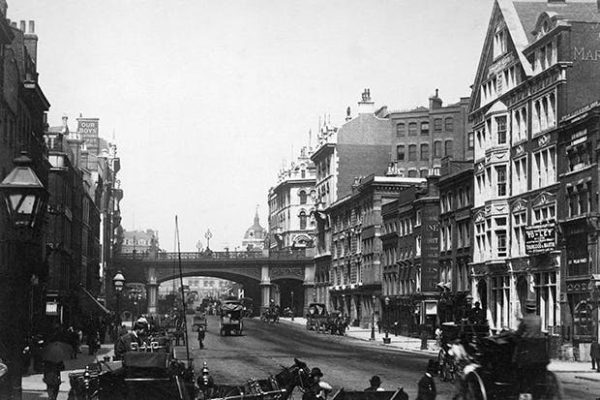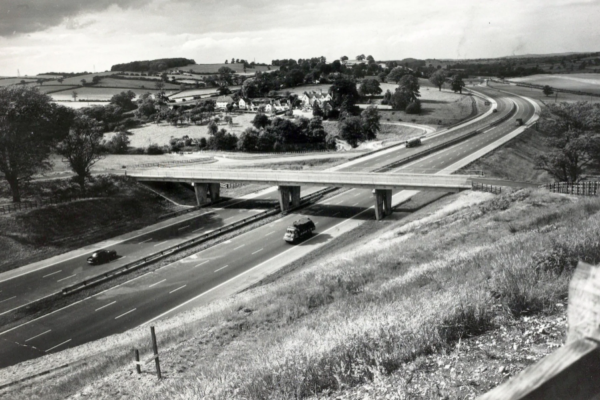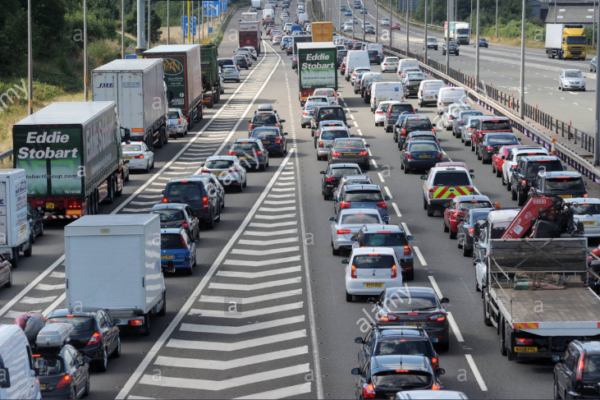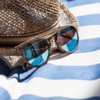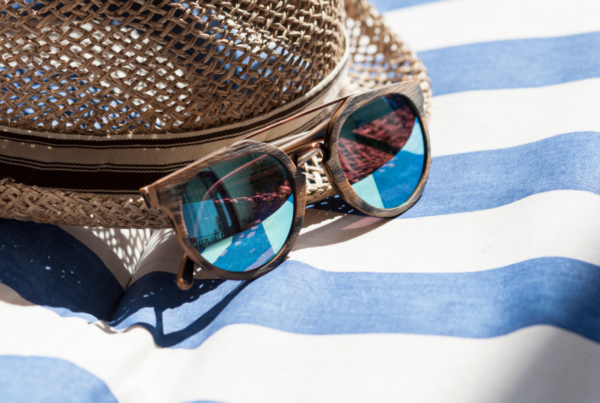Spectacle Lenses for Driving
In recent years there has been a lot of hype around lens types and coatings, especially those spectacle lenses that are designed to enhance the driving experience. To appreciate why these lenses have been developed, we have to look back at the history of motor vehicles and the proliferation of their use on the roads today.
We can certainly appreciate that the practice of driving has changed a lot since the introduction of the centralised licensing system by the DVLC (Driver & Vehicle Licensing Centre) set in 1965 (ref: www.gov.uk, History of road safety). The first-ever Driver Licences were introduced in Britain by the Motor Car Act in 1903 (reference www.gov.uk, History of road safety).
From left to right: Farringdon Road of London, 1900’s. Image Credit: The Spectator. Burgess Hill of London, 1900’s. Image Credit: Vintage Pics. 1st British Motorway, the M6, 1958. Image Credit: Telegraph. M6 photographed in the most recent times. Image Credit: Alamy
I often come across customers who think that all the new technological advancements in eyewear are a ‘fad’ and that they are a means to increase the value of the spectacles. This is not the case. If you observe the images of Britain’s roads from the early 1900s to date, you have to appreciate that a lot more has changed than what meets the eye.
At first glance, the early depictions of the roads in the 1900’s look fairly wide and virtually empty. Britain’s 1st motorway, the M6 was a method to connect the South of the UK to the North, and this was introduced to Britain in 1958. The most recent image of the M6 highlights a plethora of reasons for why the eyes feel such a tremendous amount of eye strain whilst driving.
Using these images, let us observe some of the modern reasons for Visual Fatigue whilst driving:
- There are more vehicles on the roads in modern times, than the 1900s
- There are different shapes and sizes of vehicles on the road in use today, including small motorbikes to 40+ Tonne Heavy Goods Vehicles (HGVs).
- Vastly a lot more road-side lamps and LED lights (increase of glare)
- With more vehicles on the road, there is increased glare from car headlamps and brake-lights. Modern cars are equipped with Xenon headlamps which to the observer create the worst type of glare. With every dip or bump in a road, the Xenon lights appear to be ‘flashing’ other road users.
- More road-signs at the side of roads and motorways, as well as signs across the top of motorways and bridges. Thus, observational cues have increased.
- Extra lanes on the roads. Motorways have been updated from 3 lanes to 4/5 lanes to accommodate the extra vehicles.
- Merging lanes
- Cars are much closer to one another, leaving less braking distance
- Hard Shoulders introduced to highways: another hazard to be observant of whilst driving since broken down vehicles may be parked here or fast emergency vehicles may be passing at high speeds
- Speed camera’s
- The early images depict clear roads with no vehicles parked on the roads. In modern times, there are cars parked in whichever space that can be found. These vehicles can be viewed as an obstruction since we cannot see if anyone will step onto the road from the side of these parked cars.
In short, the driving ethos of the early 1900s was contrastingly different from its modern counterpart. In 1921 there were 1 million drivers in Britain. By 1973, this figure had reached approximately 20 million. In recent times, since cars are becoming more affordable, there are more than 37 million vehicles on the road (ref: www.gov.uk, History of road safety). Today the cars are faster, there are additional dazzling lights on the road and there are more hazards for the driver to be aware of. Even the dashboards of our cars are more illuminated and densely packed with state-of-the-art technologies. In 2017, the DVLA changed their ‘Car Driving Test’ to include taking directions from a Sat Nav device.

Image Credit: Shutterstock
The DVLA have set a ‘Standards of vision for driving’ (see Driving eyesight rules – GOV.UK). People who have been prescribed a correction for driving must wear spectacles or contact lenses to correct their eyesight. Patients must tell the DVLA if they have any medical problems that may affect their vision.
If a patient’s vision has been corrected to the optimum level with spectacles, what else could we do to make the driving experience more comfortable?
On the proviso that a customer has been fitted with the correct prescription for driving, and that the spectacle frame is comfortable, we have to assess whether any extra features could be added to the spectacle correction to make the driving experience more pleasant. With the increase in visual demands for driving, the lens companies have had to come up with the solutions.
The Science behind Spectacle Lenses:
Before we look at ‘Spectacle Lens Solutions’, let us take a moment to appreciate the science behind optical corrections. The subject of Spectacles and their invention is still a grey area amongst modern scholars. The further we delve into history, we find more evidence that eyeglasses existed before any date labelled as the ‘invention’ date. Whilst Benjamin Franklin is renowned for his creation of ‘Bifocal’ lenses in the 1700s, he is not the inventor of eyeglass creations. Paintings exist from the mid-1300s depicting some form of vision correction. The use of magnifying lenses was described in ‘Ptolemy’s Optics’ written in Arabic. These writings were further discussed and revised in circa 1021 in the ‘Book of Optics’ by Alhazen. Latin translations of these books became available to Europe in the 12th century. (reference: Nature.com).
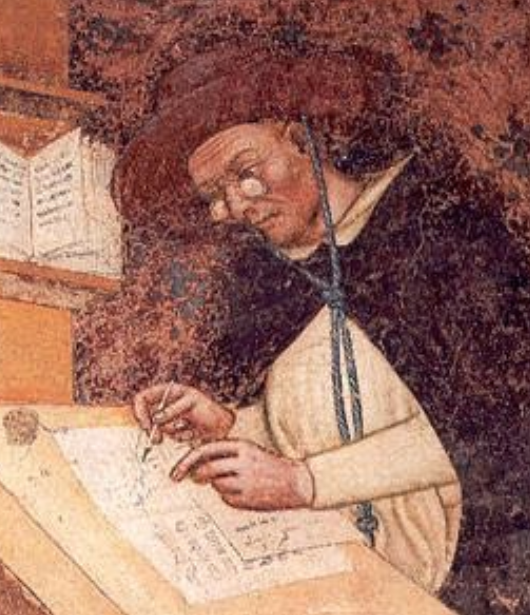
Portrait of Hugh of Saint-Cher painted In 1352. Image Credit: Wikipedia
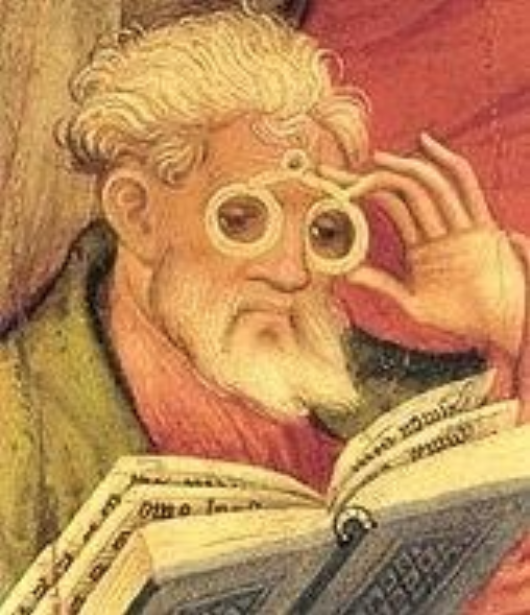
‘The Glasses Apostle’ by Conrad von Soest 1403. Image Credit: Wikipedia
Modern Lenses and their theory:
Moving forward from the 11th Century discoveries of eyeglasses, we come to a generation of lenses that are optically cleaner, clearer and better optimised to correct many visual anomalies. Every optical lens manufacturer will apply the ‘Best Form Lens Theory’ to create a product that gives the sharpest image focus at the back of the eye. In a nutshell, a ‘best-form lens’ is a lens whose curvatures are computed to eliminate or minimise image defects. These defects come in many forms, but for the sake of simplicity, the most common ones to observe, would be ‘distortion’ and ‘aberrations’.
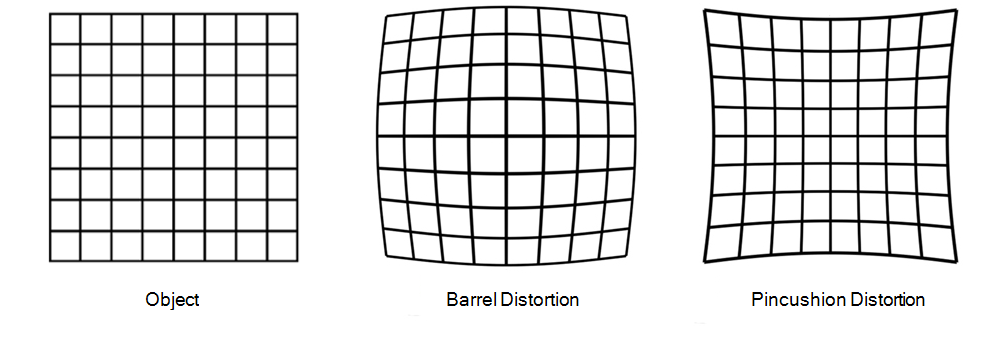
Image Credit: Foundry
Barrel distortion is typical when viewed through a ‘minus powered lens’. The image of a perfect square grid is distorted to mimic a keg or barrel. The opposite happens with pincushion distortion. ‘Plus powered lenses’ cause the outer parts of the grid image to appear larger and pinched at the centre causing the pincushion effect. These distortions are controlled by modern technology to minimise image deformations.
When a patient’s eye is viewing through the optical centre of a lens, the image viewed by the patient should be free of any image degrading or deforming defects. When the patient looks away from the centre of the lens, as we do, a ‘best form lens’ will aim to give the clearest image in the off-axis performance. When customers complain about aberrations, they will often describe these aberrations as ‘colour fringing’ or ‘blurred’ zones at the edges of the lens.
Lens manufacturers have invested a lot in the science of lens technology. Customers have so many prescription variables that solutions must be sought to correct these anomalies. Through the calculation of different lens curves and the application of various lens coatings, most optical defects have been corrected.
Driving lenses by Hoya: Enroute & Enroute Pro
Previously I highlighted that driving conditions have become more demanding. But how many people are spending more time behind the wheel of a car? In the year 2010, a 30-mile journey to work would take me approximately 45 minutes by car. Almost a decade on, the same commute is taking me 1 ½ to 2 hours depending on the traffic and road works. My home, my workplace and route to work have not changed. What has changed is the increase in the volume of commuters on the road today.
With these driving challenges, it is inevitable that a product had to be devised to aid more comfortable driving.
‘Welcome EnRoute & EnRoute Pro’
If you have a car, the probability is quite high that you’re driving on a daily basis. You could be driving to work, visiting a family member, doing the school run or going on a road trip. Driving has become an important everyday activity. Hoya have recognised this fact by conducting their own research1. To minimise eye strain, Hoya have developed lenses specifically for motorists. The EnRoute range is available in single-vision and progressive options. The following excerpt is from Hoya’s EnRoute guide.
The EnRoute Range:
“Developed to meet the visual demands of today’s drivers, EnRoute lenses are equipped with a specially developed Glare Filter. This specifically cuts light in the blue spectrum, significantly reducing light scatter and distracting glare from the dashboard, streetlights and LED and Xenon headlights of oncoming traffic. At the same time, it enhances the transmittance of necessary light, improving contrast and brightness perception, even in poor light and bad weather. The result is more comfortable, relaxed vision even in stressful driving situations. What’s more, the anti-reflection treatment has scratch resistance and water and dirt repelling properties”.
Hoya have developed a product that exceeds the expectations that a consumer may have from their everyday spectacles. A regular lens is designed to correct the prescription anomaly. The Enroute range of lenses, factors in all other issues that create stress on the visual system, when driving. Here we have a product that significantly reduces reflections and reduces glare from oncoming traffic. This lens is digitally designed to give unimpaired vision in the distance and dashboard zones whilst also enabling fast focusing of side mirrors and the rear-view mirror.
The EnRoute Pro
The ‘EnRoute Pro’ has all the features of the Hoya EnRoute product but with the added benefit of a specially developed ‘contrast-enhancing’ filter. This extra filter improves contrast in low-light conditions such as fog and bad weather driving. The EnRoute Pro was developed for professional drivers (bus and coach drivers, lorry drivers, taxi drivers, emergency service drivers). However, the extra filter is beneficial to anyone who has issues of contrast sensitivity. The contrast-enhancing filter appears as a brown/yellow tint to an absorption level of 10-12%, hence a slight residual tint is apparent when viewing this lens.
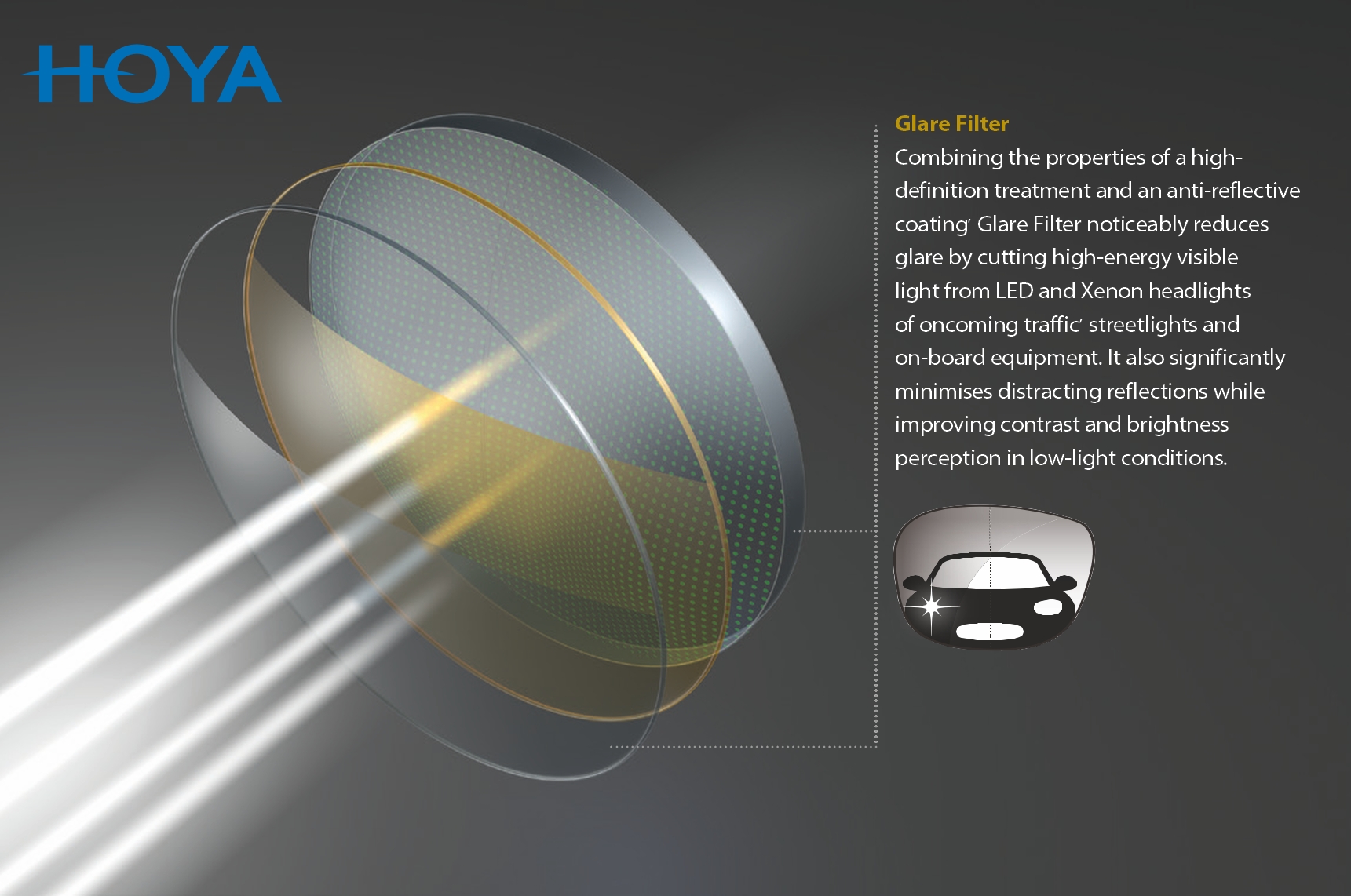
Image Credit: Hoya Vision
The EnRoute Pro: Progressive Lens
The Progressive or Varifocal products in the EnRoute Pro range are customised to be driving specific. The lens is distance and dashboard biased, unlike standard varifocals which have an overall balanced design. This is not to discredit the balanced varifocal lenses produced by so many multifocal manufacturers. The latter lenses have a great general-use template. However, where customers are feeling increased visual fatigue and stress for driving, the EnRoute Pro Progressive is especially focused on the visual demands for driving.
All varifocal manufacturers are striving for a distortion-free progressive lens. But, the fact remains that a varifocal has to blend different focal lengths into 1 moulded lens and inevitably this will give rise to distortion where the prescriptions blend from far to near focus. I describe this distortion to first time varifocal wearers as the distortion viewed through the windowpane of a bus or coach. The window is clear all around but where the window pane bends at the edges, it gives rise to distortion at those bend points. Similarly, where the focal lengths vary down the progression of a varifocal, this will give rise to distortion. Modern lenses are getting much closer to pushing these nuisance zones away from our main viewing areas but they have not been eliminated completely.
Image Credit: Pixabay
With balanced varifocals, the distorted zones are pushed to the further most points of a lens and some of the distortion is pushed into the distance area. With a distance specific varifocal such as the EnRoute Pro product, the lens is already calculated to give the optimum off-axis performance but it also pushes the distortion lower down the lens corridor so that the Distance and Intermediate zones have a wider field of view.
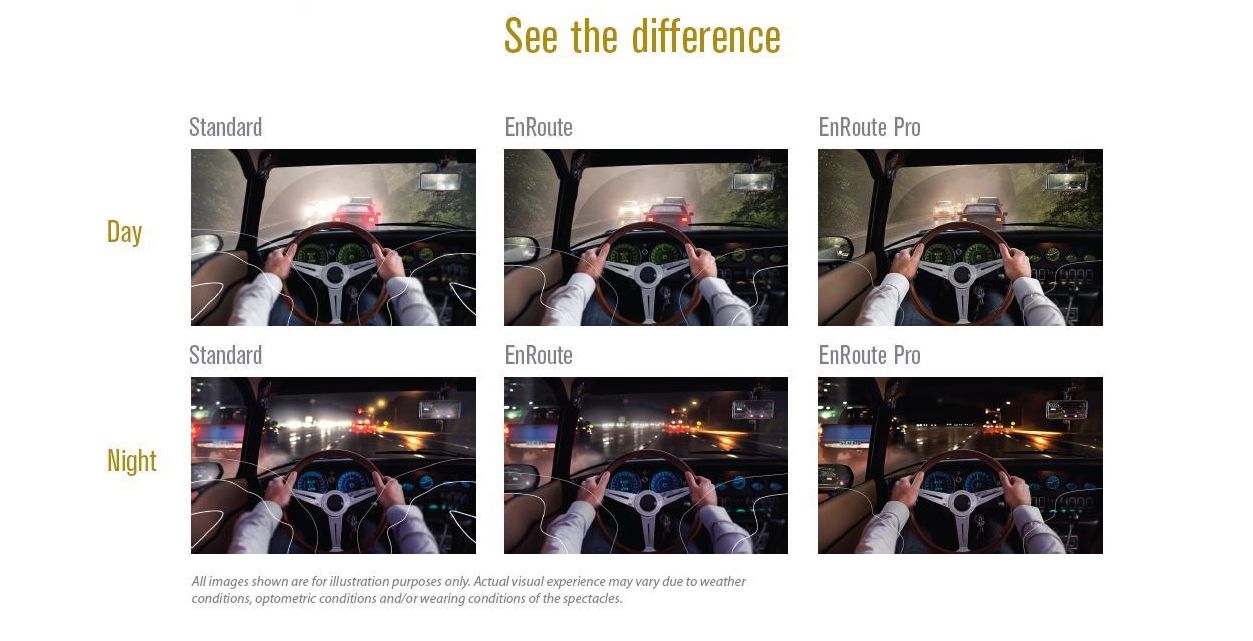
Image Credit: Hoya Vision
Video Credit: Hoya Vision
My Observations – EnRoute
I first tried my spectacles at work. My lens prescription was new so I had to adapt to this new correction as well as make observations of the lens type. I chose the EnRoute lens rather than the Pro because I needed a universal lens that would be suitable for indoor use as well as for driving. Hence, I chose the clearer lens rather than the Pro alternative which exhibits a slight residual tint.
Immediately I observed that the anti-glare coat had a more natural hue to it when compared to some of the leading competitors. I have other spectacles with the Blue-anti glare coating on them, and whilst I like them, cosmetically they look better with black, grey or blue frames. Since my new frame was a warmer colour, I wanted a coating that would complement this style. The anti-glare coating provided with the entire EnRoute range is of a high standard and with a low blue/lilac reflection. The EnRoute also has a slight tint comparable to a grey hue but it is barely noticeable and can only be observed when placed on a white service. Looking through the lens, everything was very clear and colours seemed unaltered and natural.
My favourite feature about the EnRoute range is the full UV protection provided by its anti-glare coating. I have compared the UV protection of the Hoya EnRoute versus other competitive brands and the Hoya lens cuts out all of the harmful UV up to 410nm. This feature is so important because I feel that I am protecting my eyes even when I am not wearing sunglasses or photochromic lenses.
For this reason, I would be very confident to prescribe the Hoya EnRoute and the EnRoute Pro to a full patient base. These lenses are not solely for driving. They are to be appreciated indoors for general use as well as outdoors since it provides 100% UV protection. This would be excellent for so many customers especially those where the UV is of concern (protection against cataracts is an example).
Video Credit: Hoya Vision
Driving Experience:
I received my EnRoute spectacles January 2019. The weather has varied a lot over the past months with some days that were icy cold, foggy, raining hard, sleet and hale. Couple that with the dark, early drive to work, and equally very dark evenings on my journey home. I experienced every type of driving visual strain. I have worn spectacles for approximately 30 years so I am very accustomed to allowing my eyes to adapt to any new prescription for a few days. I had already tested my new glasses at work and at home, but now I was going to give them their first test run on the road. The results are very pleasing.
As I set off on my regular commute to work, my intention was to test the spectacles without overthinking it too much. The idea was to drive on my usual journey to work, at the same time with the regular everyday commuters and the current roadworks on the M4 motorway along the stretch from Heathrow to Reading. For people who are currently doing this commute, you can sympathise that the 50mph limit and tight lanes are a difficult journey to muster at 7.30 am. I appreciate that the resultant ‘new motorway’ will aim to be more proficient but the intermediary traffic is an absolute nightmare! I couldn’t have picked a greater time to test the new EnRoute product.
In a nutshell, the lenses are excellent to look through. As for the driving experience, the eyes feel much more relaxed than usual. I could definitely appreciate the contrast and clarity. Whenever I would stop at traffic lights, I would look over the top of the specs and then through them again. The colour through the lenses seemed to be more natural and it dulled down the very white and blue lights being emitted from other car headlamps as well as the roadside lights. The dashboard of my car is illuminated with 3 main light-emitting colours which are blue, red and white. With the specs in situ, the dashboard of the car and my road navigation system were easy to view because the colours were more comfortable to the eyes.
The modern driver has adapted to the greater visual demands of today, so any products that ease the stress on the eyes should be warmly welcomed. In conclusion, the Hoya EnRoute is a fabulous product and should be readily recommended to all customers.
Maintenance:
I tend to wear a variety of spectacles to work to match my outfits. Another observation was that the Hoya EnRoute lenses are easy to clean and are much more dust repellent than some other branded lenses that I have used.
Overall, this is a top product ticking all the boxes required from spectacle lenses. Visual performance, UV protection, easy to care for and superior coatings to meet all the demands of modern-day driving.
1 Hoya data collected over 3 years with Hoya iDentifier
Posts by Oodo may include affiliate links. This means that we make a small commission from referrals and purchases at no extra cost to you. Thank you for your kind support.


